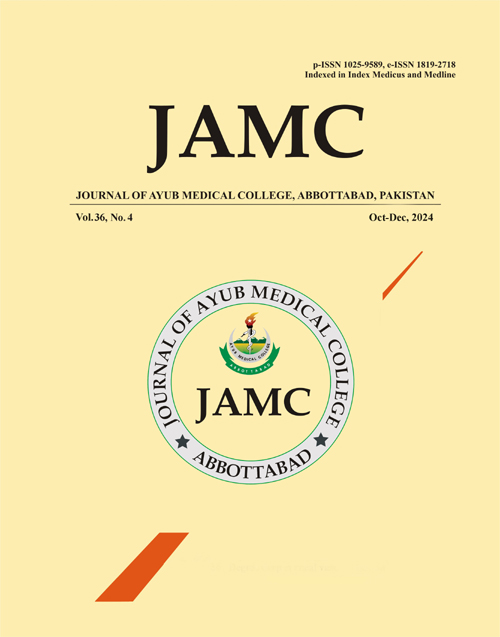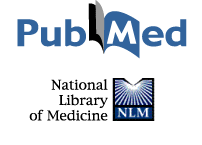THE RATE AND TIME TO FIRST READMISSION IN PATIENTS DISCHARGED WITH A DIAGNOSIS OF ACUTE DECOMPENSATED HEART FAILURE ADMITTED TO THE CARDIOLOGY DEPARTMENT, AYUB TEACHING HOSPITAL, ABBOTTABAD
DOI:
https://doi.org/10.55519/JAMC-04-13550Keywords:
Acute Decompensated Heart Failure, ReadmissionAbstract
Background: Admission for heart failure poses a significant risk of readmission. Evaluating readmission rates in settings lacking chronic disease management programs could provide valuable insights to advocate for the establishment of such services. Methods: This study focused on patients admitted to the Cardiology Department of Ayub Medical Teaching Institute with acute decompensated heart failure. After excluding patients based on exclusion criteria, demographic and clinical data were recorded, including symptoms, signs, discharge medications, and readmission status within 6 months. Patients not readmitted were contacted via telephone at 1, 3, and 6 months. Readmission rates and time to first readmission or death were documented. Results: A total of 222 patients were enrolled, with 60% being males. All patients exhibited pulmonary congestion, with 85% classified as NYHA Class III or IV. Comorbidities included hypertension (59%), history of myocardial infarction (45.49%), and diabetes (38.28%). Within 6 months, 21% of patients were readmitted, and 13% died before readmission, resulting in an overall death or readmission rate of 34% at 6 months. No significant differences were observed between readmitted and non-readmitted patients regarding sex, age, creatinine levels, haemoglobin levels, sodium levels, or ejection fraction. Utilization of guideline-directed medical treatment was low. Conclusion: The high rate of readmission or death among patients admitted with acute decompensated heart failure underscores the necessity for implementing multidisciplinary care to closely monitor these patients.
References
1. Kemp CD, Conte JV. The pathophysiology of heart failure. Cardiovasc Pathol 2012;21(5):365–371.
2. GBD 2017 Disease and Injury Incidence and Prevalence Collaborators. Global, regional, and national incidence, prevalence, and years lived with disability for 354 diseases and injuries for 195 countries and territories, 1990–2017: a systematic analysis for the Global Burden of Disease Study 2017. Lancet 2018;392(10159):1789–1858.
3. Belfiore A, Palmieri VO, Di Gennaro C, Settimo E, De Sario MG, Lattanzio S, et al. Long-term Management of Chronic Heart Failure Patients in Internal Medicine. Intern Emerg Med 2020;15(1):49–58.
4. Gheorghiade M, Vaduganathan M, Fonarow GC, Bonow RO. Rehospitalization for heart failure. Problems and perspectives. J Am Coll Cardiol 2013;61(4):391–403.
5. McLaren DP, Jones R, Plotnik R, Zareba W, McIntosh S, Alexis J, et al. Prior hospital admission predicts thirty-day hospital readmission for heart failure patients. Cardiol J 2016;23(2):155–62.
6. Ranasinghe I, Wang Y, Dharmarajan K, Hsieh AF, Bernheim SM, Krumholz HM. Readmissions after Hospitalization for Heart Failure, Acute Myocardial Infarction, or Pneumonia among Young and Middle-Aged Adults: A Retrospective Observational Cohort Study. PLoS Med 2014;11(9):e1001737.
7. McAlister FA, Stewart S, Ferrua S Mcmurray JJ. Multidisciplinary strategies for the management of heart failure patients at high risk for admission: a systematic review of randomized trials. J Am Coll Cardiol 2004;44(4):810–9.
8. Wideqvist M, Cui X, Magnusson C, Schaufelberger M, Fu M. Hospital readmissions of patients with heart failure from the real world: timing and associated risk factors. ESC Heart Fail 2021;8(2):1388–97.
9. Suter LG, Li SX, Grady JN, Lin Z, Wang Y, Bhat KR, et al. National patterns of risk-standardized mortality and readmission after hospitalization for acute myocardial infarction, heart failure, and pneumonia: update on publicly reported outcomes measures based on the 2013 release. J Gen Intern Med 2014;29(10):1333–40.
10. Wasfy JH, Zigler CM, Choirat C, Wang Y, Dominici F, Yeh RW. Readmission rates after passage of the hospital readmissions reduction program: a pre-post analysis. Ann Intern Med 2017;166(5):324–331.
11. Shah KS, Xu H, Matsouaka RA, Bhatt DL, Heidenreich PA, Hernandez AF, et al. Heart failure with preserved, borderline, and reduced ejection fraction: 5-year outcomes. Am Coll Cardiol 2017;70(20):2476–86.
12. Krumholz HM, Parent EM, Tu N, Vaccarino V, Wang Y, Radford MJ, et al. Readmission After Hospitalization for Congestive Heart Failure among Medicare Beneficiaries. Arch Intern Med 1997;157:99–104.
13. Rich MW, Vinson JM, Sperry JC, Shah AS, Spinner LR, Chung MK, et al. Prevention of readmission in elderly patients with congestive heart failure - Results of a prospective, randomized pilot study. J Gen Intern Med 1993;8(11):585–90.
14. Vinson JM, Rich MW, Sperry JC, Shah AS, McNamara T. Early Readmission of Elderly Patients with Congestive Heart Failure. J Am Geriatr Soc 1990;38(12):1290–5.
15. Gerber Y, Weston SA, Redfield MM, Chamberlain AM, Manemann SM, Jiang R, et al. A contemporary appraisal of the heart failure epidemic in Olmsted County, Minnesota, 2000 to 2010. JAMA Intern Med 2015;175(6):996–1004.
16. Smeets M, Vaes B, Mamouris P, Van Den Akker M, Van Pottelbergh G, Goderis G, et al. Burden of heart failure in Flemish general practices: a registry-based study in the Intego database. BMJ Open 2019;9(1):e022972.
17. Christiansen MN, Køber L, Weeke P, Vasan RS, Jeppesen JL, Smith JG, et al. Age-specific trends in incidence, mortality,and comorbidities of heart failure in Denmark,1995 to 2012. Circulation 2017;135(13):1214–23.
18. Lip GY, Skjøth F, Overvad K, Rasmussen LH, Larsen TB. Blood pressure and prognosis in patients with incident heart failure: the Diet, Cancer, and Health(DCH) cohort study. Clin Res Cardiol 2015;104(12):1088–96.
19. Ather S, Chan W, Bozkurt B, Aguilar D, Ramasubbu K, Zachariah AA, et al. Impact of noncardiac comorbidities on morbidity and mortality in a predominantly male population with heart failure and preserved versus reduced ejection fraction. J Am Coll Cardiol 2012;59(11):998–1005.
20. Al-Tamimi MAA, Gillani SW, Abd Alhakam ME, Sam KG. Factors Associated with Hospital Readmission of Heart Failure Patients. Front Pharmacol 2021;12:732760.
21. Ponikowski P, Anker SD, Al-Habib KF, Cowie MR, Force TL, Hu S, et al. Heart failure: preventing disease and death worldwide. ESC Heart Fail 2014;1(1):4–25.
22. Parizo JT, Kohsaka S, Sandhu AT, Patel J, Heidenreich PA. Trends in Readmission and Mortality Rates Following Heart Failure Hospitalization in the Veterans Affairs Health Care System From 2007 to 2017. JAMA Cardiol 2020;5(9):1042–7.
23. Hafkamp FJ, Tio RA, Otterspoor LC, de Greef T, van Steenbergen GJ, van de Ven ART, et al. Optimal effectiveness of heart failure management - an umbrella review of meta-analyses examining the effectiveness of interventions to reduce (re)hospitalizations in heart failure. Heart Fail Rev 2022;27(5):1683–1748.
24. McDonagh TA, Cleland J, Dargttie H, Whittaker T, Standing M, Mitchell P, et al. National Heart Failure report: April 2010-March 2011. National Institute For Cardiovascular Outcomes Research (NICOR). 2012.
25. Hansen LO, Young RS, Hinami K, Leung A, Williams MV. Interventions to Reduce 30-Day Rehospitalization: A Systematic Review. Ann Intern Med 2011;155(8):520–8.
26. Tuso P, Watson HL, Garofalo-Wright L, Lindsay G, Jackson A, Taitano M, Koyama S, Kanter M. Complex case conferences associated with reduced hospital admissions for high-risk patients with multiple comorbidities. Perm J 2014;18(1):38–42.
27. Cleland JG, Swedberg K, Follath F, Komajda M, Cohen-Solal A, Aguilar JC, et al. The EuroHeart Failure Survey Programme: Survey on the quality of care among patients with heart failure in Europe. Part 1: Patient characteristics and diagnosis. Eur Heart J 2003;24:442–63.
28. McDonald K, Ledwidge M, Cahill J, Quigley P, Maurer B, Travers B, et al. Heart Failure Management: Multidisciplinary Care Has Intrinsic Benefit above the Optimization of Medical Care. J Card Fail 2002;893):142–8.
29. Cox ZL, Nandkeolyar S, Johnson AJ, Lindenfeld J, Rali AS. In-hospital Initiation and Up-titration of Guideline-directed Medical Therapies for Heart Failure with Reduced Ejection Fraction. Card Fail Rev 2022;8:e21.
30. Greene SJ, Butler J, Albert NM, DeVore AD, Sharma PP, Duffy CI, et al. Medical therapy for heart failure with reduced ejection fraction: the CHAMP-HF registry. J Am Coll Cardiol 2018;72(4):351–66.
31. Driscoll A, Krum H, Wolfe R, Tonkin A. Nurse-led titration of beta-blockers can improve outcomes in chronic heart failure patients in the community. J Card Fail 2011;17:224–30.
32. Driscoll A, Currey J, Tonkin A, Krum H. Nurse-led titration of angiotensin converting enzyme inhibitors, beta-adrenergic blocking agents and angiotensin receptor blockers for patients with left ventricular systolic dysfunction Review. Cochrane Database Syst Rev 2015;12:CD009889.
33. Driscoll A, Meagher S, Kennedy R, Hay M, Banerji J, Campbell D, et al. What is the impact of systems of care for heart failure on patients diagnosed with heart failure: a systematic review? BMC Cardiovasc Disord 2016;16(1):195.
34. Baptiste DL, Mark H, Groff-Paris L, Taylor LA. A nurse- guided patient- centered heart failure education program. J Nurs Educ Pract 2014;4(3):49–57.
35. Akosah KO, Schaper AM, Havlik P, Barnhart S, Devine S. Improving care for patients with chronic HF in the community: the importance of a disease management programs. Chest 2002;122(2):906–12.
36. Krumholz HM, Amatruda J, Smith GL, Mattera JA, Roumanis SA, Radford MJ, et al. Randomized trial of an education and support intervention to prevent readmission of patients with HF. J Am Coll Cardiol 2002;39(1):83–9.
37. Del Sindaco D, Pulignano G, Minardi G, Apostoli A, Guerrieri L, Rotoloni M, et al. Two-year outcome of a prospective, controlled study of a disease management programme for elderly patients with heart failure. J Cardiovasc Med (Hagerstown) 2007;8(5):324–9.
Downloads
Published
How to Cite
Issue
Section
License
Copyright (c) 2024 Saad Shams, Imran Khan, Rukhshanda Afsar, Fatima Javed, Zia Ullah Khan, Aftab Ahmad, Mati Ullah Khan

This work is licensed under a Creative Commons Attribution-NoDerivatives 4.0 International License.
Journal of Ayub Medical College, Abbottabad is an OPEN ACCESS JOURNAL which means that all content is FREELY available without charge to all users whether registered with the journal or not. The work published by J Ayub Med Coll Abbottabad is licensed and distributed under the creative commons License CC BY ND Attribution-NoDerivs. Material printed in this journal is OPEN to access, and are FREE for use in academic and research work with proper citation. J Ayub Med Coll Abbottabad accepts only original material for publication with the understanding that except for abstracts, no part of the data has been published or will be submitted for publication elsewhere before appearing in J Ayub Med Coll Abbottabad. The Editorial Board of J Ayub Med Coll Abbottabad makes every effort to ensure the accuracy and authenticity of material printed in J Ayub Med Coll Abbottabad. However, conclusions and statements expressed are views of the authors and do not reflect the opinion/policy of J Ayub Med Coll Abbottabad or the Editorial Board.
USERS are allowed to read, download, copy, distribute, print, search, or link to the full texts of the articles, or use them for any other lawful purpose, without asking prior permission from the publisher or the author. This is in accordance with the BOAI definition of open access.
AUTHORS retain the rights of free downloading/unlimited e-print of full text and sharing/disseminating the article without any restriction, by any means including twitter, scholarly collaboration networks such as ResearchGate, Academia.eu, and social media sites such as Twitter, LinkedIn, Google Scholar and any other professional or academic networking site.










